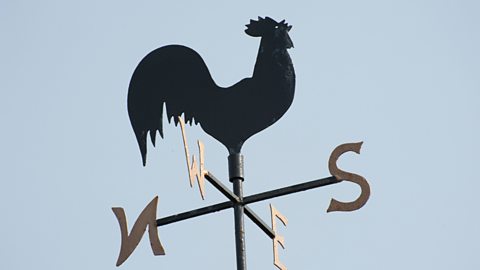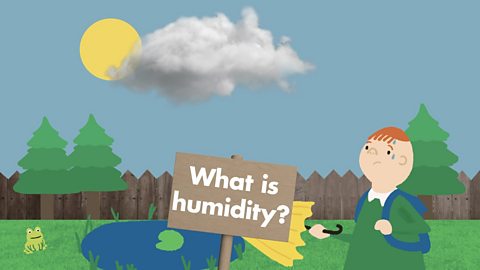What is wind?
Whether it's blowing a gale or just a gentle breeze, we've all felt the wind. Wind can come from different places, which can impact the weather we experience.
In this article you can learn:
- What wind is
- How to measure wind direction
- What Earth's atmosphere is
- High and low air pressure
This resource is suitable for weather topics for primary school learners.
Video - What is wind?
Watch this video to learn about air pressure and wind direction.
Have you ever felt a freezing gust of wind in the wintertime or a warm breeze during the summer? Then you have felt two different types of wind.
But what is wind, and where does it come from?
The Earth has a layer of air around it, called the atmosphere - and it isn’t equally spread. In some places, the atmosphere is thicker – there is more air squeezed in over the ground. We call this high pressure. In some places, the atmosphere is thinner with less air taking up the same space. We call this low pressure.
The differences in air pressure make the air move. A bit like air rushing out of an inflated balloon, the air moves from places with high pressure to places with low pressure. We call this moving air wind. The bigger the difference in air pressure,the faster the wind.
Winds are named by the compass direction they are coming from - north, south, east or west.
Northerlies can be bitterly cold in winter as they are moving cold air from the northern Arctic Regions.
Southerly winds bring in warmer air from Southern Europe or Africa and make the weather warmer. And Westerlies bring rain as the winds carry a lot of moist air full of water vapour from the Atlantic Ocean.
Easterly winds come from over Europe. Because they come from over land instead of the ocean, they bring drier air.
Have you ever noticed that it’s very windy when you’re in a wide open space or on top of a hill? This is because there aren’t as many objects such as buildings, trees, hills and mountains that get in the way of the wind. Any obstacles like these cause friction when the air brushes past them and this slows the wind down.
In the UK the strongest recorded wind was 173mph, it was recorded at Cairngorm summit in Scotland in 1986. You wouldn’t want to get caught inthat!
The windiest place in the world is Antarctica. It can be hard to measure though, because its winds can be so strong that they can destroy the measuring instruments!
When you’re out on a windy day and can feel and see the effects of the wind, try and guess where it’s coming from. Is it a northerly? Is the wind being affected by the buildings or the landscape around you?
Where does wind come from?
- The Earth has a layer of air around it called the atmosphere.
- The atmosphere isn't evenly spread.
- In some places the air squeezes together over the ground. We call this high pressure.
- In other places there is less air that is more spread out. This makes the atmosphere thinner. We call this low pressure.
- The air moves from places with high pressure to places with low pressure. We call this moving air wind.
Windy weather
Click through this slideshow to learn about different parts of windy weather from weather vanes to wind in the Antarctic.

Image caption, Wind direction
A weather vane shows wind direction. The top turns to face the wind. You can compare this with the points of the compass, N for north, E for east, W for west and S for south. The cockerel on this weather vane shows the wind is coming from the south.
Image caption, Wind speed
An anemometer measures the speed of wind. It has three cups that catch the wind and spin round. The anemometer counts the number of times the cups spin round, giving you the wind speed.
Image caption, Wind power
Wind turbines are built up high or even out at sea where it is windiest. That means they can generate lots of electricity.
Image caption, Windy day by the sea
It can be very windy by the sea where there are no buildings to block the wind's path.
Image caption, Cairn Gorm summit
The strongest wind in the UK was recorded at Cairn Gorm summit in the Scottish Highlands. It measured 173 miles per hour!
Image caption, Wind in the Antarctic
Winds in the Antarctic have got up to nearly 200 miles per hour - not very nice for penguins!
1 of 6
How to measure wind direction
Video - Measuring wind direction
With help from ±«Óătv Weather's Kawser Quamer, learn:
- Why it is important to measure wind direction
- How we measure wind direction
- What a weather vane is
- What a wind sock is
KAWSER: There's a strong wind coming across the country today. And if we take a look at the weather map. We can see these white arrows showing the wind coming in from the southwest, spreading across the country.
But why is it so important knowing which direction the wind is coming from? And how do we measure it?
Knowing about wind direction is important for many people and activities. Planes point into the wind to help them take off. Sailors and windsurfers need to know the wind direction, so they can move their sails to be blown in the right direction.
Weather forecasters will try to work out the direction the wind has come from and what weather that will bring.
Wind direction is easy to measure. You can use a weather vane, a wind sock or even a flag or ribbon. Even though we can't see wind, we can see and feel the effects of air moving. Leaves on trees, flags and hair being blown.
Wind direction is worked out using a compass, which shows the directions: north, south, east and west.
A weather vane shows the compass directions and needs to be lined up with the north point on a compass. Weather vanes are usually placed high up on a building or a tall mast, so that other buildings or trees don't get in the way. The wind causes the weather vane to move and point in the direction that the wind is coming from.
If the wind comes from the west, we call it a westerly wind. Westerly winds blow in over the Atlantic Ocean and often bring mild, wet weather. If the wind changes and comes in from the east. It's called an easterly wind. These blow from over mainland Europe and often bring drier weather. If the wind comes from the north, it's a northerly wind and often brings colder weather. And finally, if the wind comes up from the south, it's a southerly wind and will often bring warmer weather.
We can also measure wind direction using a wind sock. You might have seen a wind sock at an airport. Pilots use them to see the wind direction. Windsocks point away from the wind. They also show wind speed. The higher the sock is flying, the stronger the wind is.
PUPIL: Put the wind sock in the air and look at the direction it's pointing.
PUPIL: The wind sock points in the opposite direction from where the wind is coming from. Compare this to a compass to see which direction the wind is coming from.
PUPIL: There is a southwesterly wind today.
KAWSER: So now you know how to measure wind direction, maybe you can find out where the wind is coming from where you are and what weather it might bring with it.

Key words about wind and air pressure
- wind - Air which moves in a particular direction.
- atmosphere - A layer of air which surrounds the Earth.
- high air pressure - The atmosphere is thicker with more air squeezed in over the ground.
- low air pressure - The atmosphere is thinner with less air taking up the same space.
- northerlies - Cold winds which come from the Arctic.
- southerlies - Warm winds which bring air from southern Europe and Africa.
- westerlies - Moist winds which bring rain from the Atlantic.
- easterlies - Winds from Eastern Europe which bring drier air.
- friction - A force that slows down objects that rub up against each other.
Test your knowledge
Quiz
Challenge

Write a poem about a windy day.
Now you know a lot more about wind, why not try writing a poem about a windy day?
Windy Day Poems
Some poems about windy days.

How to write poetry. revision-guideHow to write poetry
Learn how to get your ideas from your head and into your poem.

More on Weather
Find out more by working through a topic
- count6 of 22

- count7 of 22

- count8 of 22

- count9 of 22
